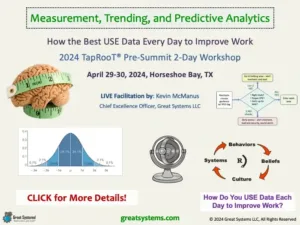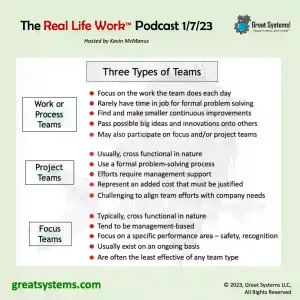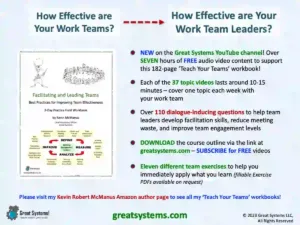Measure and Improve Your Job Design Work System
Time is the ultimate constraint when it comes to improving organizational performance. We are at a point in our organizations where we can rarely expect to get more hours per week out of our people. As a nation, we already put in more work days and hours per year than most countries.
Additionally, more and more people claim that they are too busy. Worse yet, they are stressed out and burned out. How do you measure and improve your job design work system to address such problems?
Also, the need to maintain a work-life balance has become more and more important to our employees. With all of these factors in play, we still try to get more out of our people. We repeatedly expect them to ‘do more with less.’ Great job design matters today more than ever.
If there was ever a time where we need to ‘work smarter, not harder’, it is now. High performance organizations – those that truly sustain process excellence – have figured this out.
They have torn down their silos. The old way of thinking was replaced with one that is value stream and process focused. They have streamlined their team infrastructures, aligned and coordinated their meetings. Waste has been removed out of all key processes, while also increasing customer value.

Can all organizations achieve similar results?
The answer is ‘Yes, they can.’ Leaders must rethink their organizational job designs, and not just those people use to work on the front lines. Today, our greatest organizational waste streams exist in the middle and upper management levels.
Simple headcount reduction in these areas won’t systematically change the manner in which people do their work each day. We have to systematically change our job designs.
Time is the ultimate constraint to process excellence and high performance. We can’t go to the bank and get more time. It is also unreasonable to expect our people to give us more time than they are already giving us.
In turn, if we want to go faster and get better results, we have to use this limited resource more effectively.
Why is great job design critical to high performance?
Most organizations have job descriptions, but many fail to specify in those one or two page documents how people should spend their time on the job. Most often, it the case that a list of expectations exists, along with regular job tasks. There is no reference to the percent of time one should use in these areas. Why are time percentages necessary?
Time percentages are necessary for two reasons. First, time and money are the two main things we invest on the job each day. In turn, when we spend our time in areas where we don’t need to, or in areas that don’t give us that much performance improvement leverage, we create waste.
When we identify expectations in job descriptions, but fail to also include time percentages, we assume that people will spend their work time wisely. Unfortunately, humans have proven to be less than dependable when it comes to wise time usage.
Do You Know What Your Major Time Buckets Cost?
Second, most people do not do a very good job of tracking how they spend their time each day. This is especially true if you work in an environment that focuses on crisis. As you get caught up in a crisis, your emotions overwhelm your mind’s ability to keep track of time. Similarly, when you intensely focus on task execution, it is difficult to track the minutes and hours that pass.
Time is the ultimate constraint to process excellence and high performance. We can’t go to the bank and get more time. It is also unreasonable to expect our people to give us more time than they are already giving us. In turn, if we want to go faster and get better results, we have to use this limited resource more effectively.
Where is the bulk of the time waste in your organization?
Organizations invest a lot of time and money to define how time is spent on front line work. As an Industrial Engineer, I can personally measure down to the tenth of a second how long it should take to do such work.
On occasion, I have been asked to take a similar look at middle management-level jobs. This practice was much more the exception than the rule.
In our current applications of lean six sigma and process improvement approaches, we continue to focus a disproportionate amount of time on front line work team job performance. We largely ignore the waste that exists in our higher wage rate leadership and process support jobs.
I believe that we have reached a point in the evolution of business where we have ‘nickel and dimed’ front line work team performance to death. At the same time, we largely ignore the time inefficiencies of management. This ignorance appears to become greater as you go higher up in the organization.
Should we assume that because we pay these people so much money, they are solely responsible for spending their time in the best way possible? Think about it!
Does Your Job Design Work System Provide Enough Improvement Time?
If you do not invest enough time with people, and on process improvement (primarily projects and data analysis), you can’t improve. It’s that simple. Unfortunately, in most organizations, we limit the amount of formal process improvement time that actually exists in our prevailing managerial job designs. We must take waste out of these jobs to ‘find improvement time.’
Until we do so, we will struggle to make the shift from reactive management to proactive management. We must improve our job design work system. To do this, we must find support work process waste and make changes to eliminate it. This will create more time for improvement. Do you need to improve your job design work system?
How many teams do you have? How effective are your teams? Are they really working on the right things? Using the Team Infrastructure Blueprint to identify current and future teams needs can help you keep from wasting limited resources on team activities.
How do you really spend your limited time each day?
Who makes more per hour, a front line employee or a manager? Does this wage rate increase or decrease as you move upwards on the organizational chart?
Who in your company measures their personal time use on an hour by hour basis? Which work groups have their time measured by someone else? What are the reasons for measuring the low wage rate people to a high degree and only measuring the people that make a lot more money per hour only at times, if at all?
Would it help if you chose to make some changes in your time measurement practices? Are your managers truly spending their time in a way that increases customer value? How do they know?
These questions are important to consider if you desire to have a high performance workplace. You should also question the logic behind the two tables shown at the right if this is your goal. In high performance workplaces, people spend more of their work time with others than they do alone.
If your new job involves more work with others, shouldn’t you not hold yourself to the same set of time measurement and usage standards?
Ten Ways to Improve Your Job Design Work System

How can I help you improve your job design work system?
Over more than 30 plus years, I have helped a variety of different organizations improve their job designs, both at the front line and management levels. Through personal experience and learning, I have discovered systematic approaches for reducing Leader Standard Waste. Examples include meeting and e-mail waste and off-task / redundant job descriptions. Effective team infrastructure redesign is also necessary to help find more improvement work time.
Do you really want to accelerate your pursuit of kaizen and operational excellence? If so, you must eliminate the non-value added time investments you currently make.
In order to accomplish this goal, you must change your job design approaches – your organizational ergonomics, if you will. You have top find time for improvement in order to improve.
Keep improving!
Kevin McManus, Chief Excellence Officer, Great Systems
WATCH over 50 kaizen and workplace health improvement videos on my Great Systems YouTube channel.
CHECK OUT my ‘Teach Your Teams’ workbooks on Amazon.com
LIKE Great Systems on Facebook
© Copyright 2024, Great Systems LLC, All Rights Reserved






